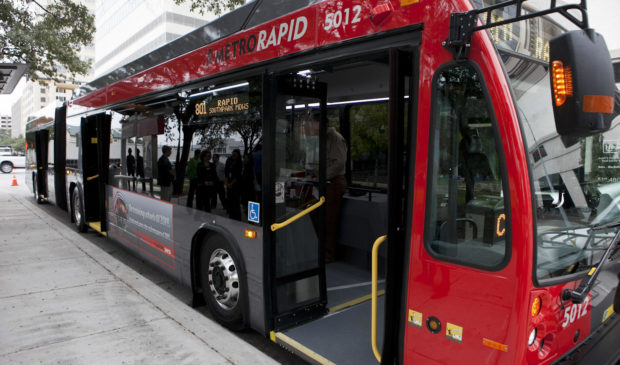Capital Metro shifts from ‘surviving to thriving’ in 2021
Thursday, April 15, 2021 by
Seth Smalley At the April 14 meeting of Capital Metropolitan Transportation Authority Board of Directors, members reviewed operations performance statistics over the last year, covering topics ranging from total ridership to vehicle collision rates to promptness of Capital Metro vehicles. (Performance metrics are also accessible via a public dashboard found on the Capital Metro website.)
Dottie Watkins, Capital Metro chief operating officer, joined by the command response rail and bus leaders, briefed the members.
“We continue to closely monitor our ridership and keep an eye on where ridership is, and do we have the right services out there? We are cautiously optimistic when we look at how we’re doing against our peers. We see ourselves toward the front of the pack in terms of the percentage of our riders we’ve won back. We didn’t dip nearly as much as some of our peers and we’ve come back relatively strong,” she said.
As eligibility expands and Covid-19 vaccination rates continue to increase, Watkins expects Capital Metro ridership to similarly increase, as things slowly get back to normal. Watkins additionally anticipates larger businesses at some point reverting back to in-office cultures, as opposed to work-from-home – another factor that will boost ridership.
“We are working on shifting our focus from surviving to thriving,” she said. “It has been no mystery that it has been a year – boy, has it been a year – but as we see our ridership going up and more and more of our staff getting vaccinated, we are able to shift our focus to increasing our ridership quality.”
Chad Ballentine, who is with Capital Metro’s demand response team, discussed MetroAccess service performance metrics over the last term, including vehicle collision rates.
“As a snapshot, our vehicle collision rates over the past year, we’ve had not many (National Transit Database) reportable vehicle collisions, which is a wonderful thing,” he said.
However, as the streets start getting busier in the post-Covid world, and Capital Metro begins to ramp up its services, Ballentine anticipates a renewed focus on caution. “That’s one of our main focuses now, to make sure we’re preparing folks for busier streets and busier times.”
On-time performance was at 95.6 percent for February, an unusually high metric that Ballentine anticipates will lower to approximately 90 percent as the pandemic lifts and ridership increases.
“On-time performance is wonderful because we don’t have a lot of passengers for our service at the moment, so it’s a lot easier for us to remain on time,” he noted.
Additionally covered at the meeting were Capital Metro initiatives over the last year, including food delivery partnerships, water and shelter trips during the winter storm, and vaccine access trips to support the community.
“We’re very close to one million meals delivered, which is just amazing to me,” said Ballentine, referring to Capital Metro’s partnership with Central Texas Food Bank. “It’s one of the reasons I love my job.”
The Austin Monitor’s work is made possible by donations from the community. Though our reporting covers donors from time to time, we are careful to keep business and editorial efforts separate while maintaining transparency. A complete list of donors is available here, and our code of ethics is explained here.
You're a community leader
And we’re honored you look to us for serious, in-depth news. You know a strong community needs local and dedicated watchdog reporting. We’re here for you and that won’t change. Now will you take the powerful next step and support our nonprofit news organization?



